
- SAP Community
- Products and Technology
- Technology
- Technology Blogs by Members
- Eclipse Based Query Modeling in BW4HANA Step by St...
Technology Blogs by Members
Explore a vibrant mix of technical expertise, industry insights, and tech buzz in member blogs covering SAP products, technology, and events. Get in the mix!
Turn on suggestions
Auto-suggest helps you quickly narrow down your search results by suggesting possible matches as you type.
Showing results for
former_member20
Active Participant
Options
- Subscribe to RSS Feed
- Mark as New
- Mark as Read
- Bookmark
- Subscribe
- Printer Friendly Page
- Report Inappropriate Content
09-09-2018
7:00 PM
The purpose of this document is to provide an overview on the new and improved eclipse based BW query modeling in BW/4HANA system and how this compares from the traditional Bex reporting.
Overview
SAP has been constantly evolving with its new innovations in terms of new application upgrades or be it with a completely new application itself as a next-generation solution with better features, integrations, performance and so on.
With BW/4HANA coming in as a next-generation data warehousing solution, SAP has finally put a full stop to very old and good Bex Query designer giving way to a whole modern, user-friendly, eclipse based BW Query modeling. The new terminology in BW/4HANA is called as BW Query.
Until recent SAP BW on HANA versions from BW7.4, BW query existed but was optional. However, from BW 7.5 on HANA SP4, the BW Query eclipse based has become mandatory which means we no longer use the Bex query designer.
BW Query provides a new, improved, well integration of BW data modeling in one single tool. Which means it is one stop place to create BW data models and Queries. For example, in the earlier version, to change query properties, you would have had to log into the back-end system with transaction codes like RSRT. But with new eclipse based query modeling, all this is achieved on a single platform. It is easy to jump from one object to another, view, change whether it Is modeling or query will be done in a single tool.

You can view the query result directly using the drill downs, filters etc., without the need to have a JAVA server for web-based querying or to switch to excel based Bex analyzer tool. What more, these queries can be accessed by other visualizations tools, for example, SAP Lumira to create more sophisticated dashboard representations.
Step by Step to create a BW Query
Let us go through each step on how to create a BW query and to have a look and feel of the eclipse based query modeling layouts and options all in one tool.
Please refer my previous posting on BW/4HANA modeling which I will use here to create a BW query on top of the info provider already existing.
Log into BW/4HANA system and connect to your BW project. Right click on the info provider, here it could be a Master data, advanced DSO, Composite provider, or anything else. Here we use the composite provider.

Provide the technical details and finish. There is an option to copy from existing BW query.
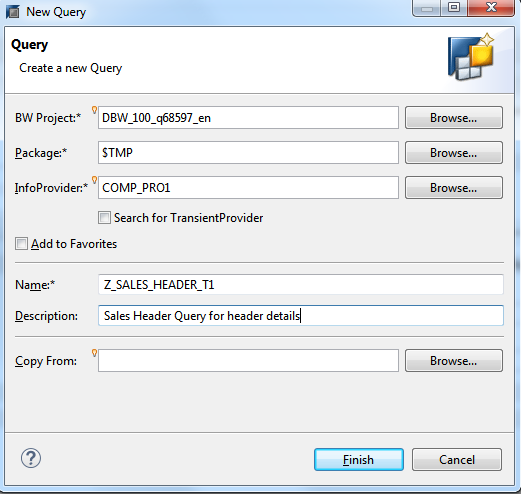
You will go to the General tab section. Here you have familiar options to set, like in Bex query designer. Suppressing results, rows, external access permissions, setting key date parameters and variables settings etc. Another new option is to generate HANA view from BW query itself. Below you can see in Remote access section.
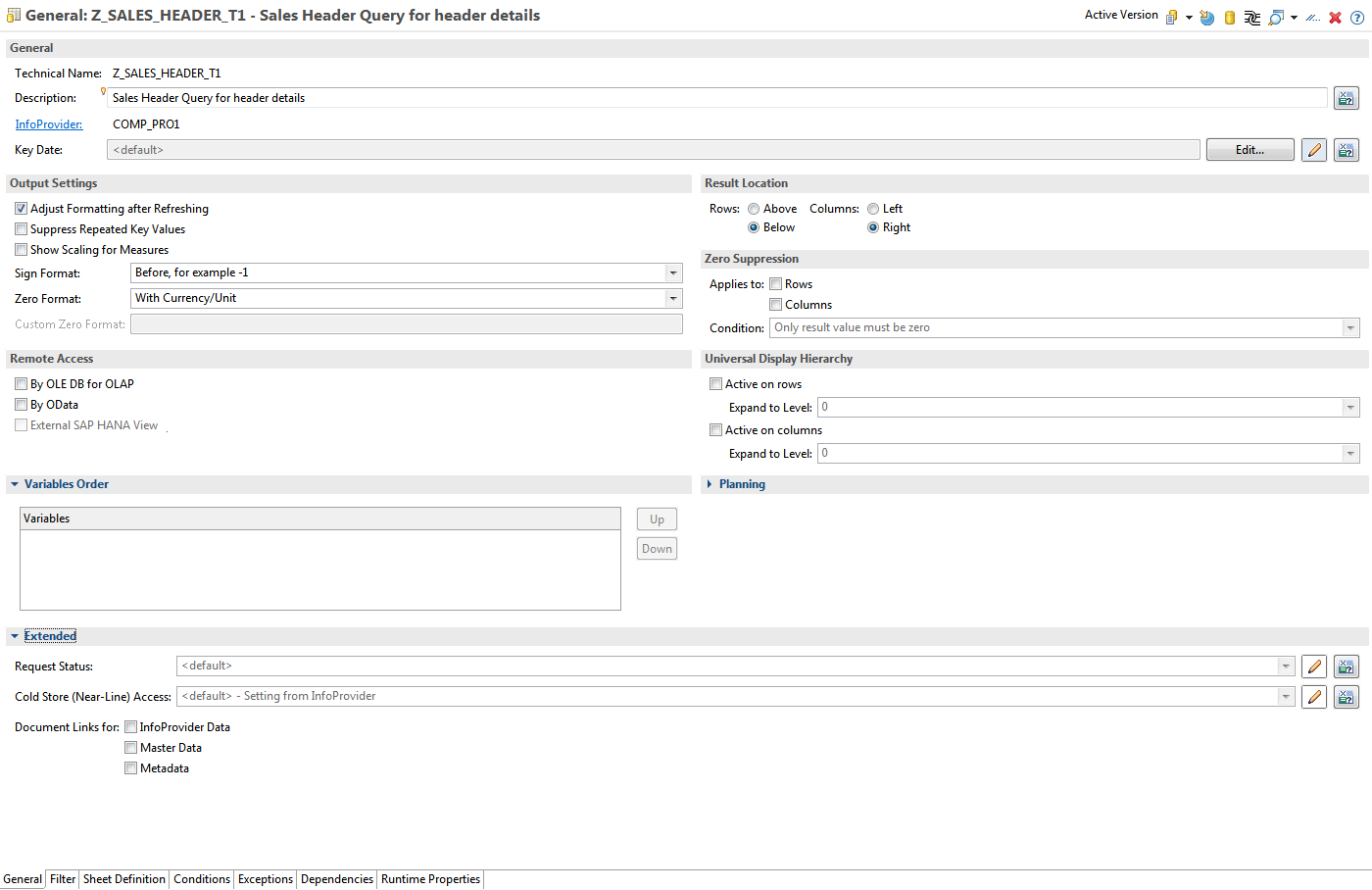
I will jump to Sheet definition as this will initial step to draw the layout of the query. As you see there are three sections which have the same name and mean the same as in old version but with a different layout.

You can find the info provider details on the top left of the screen.
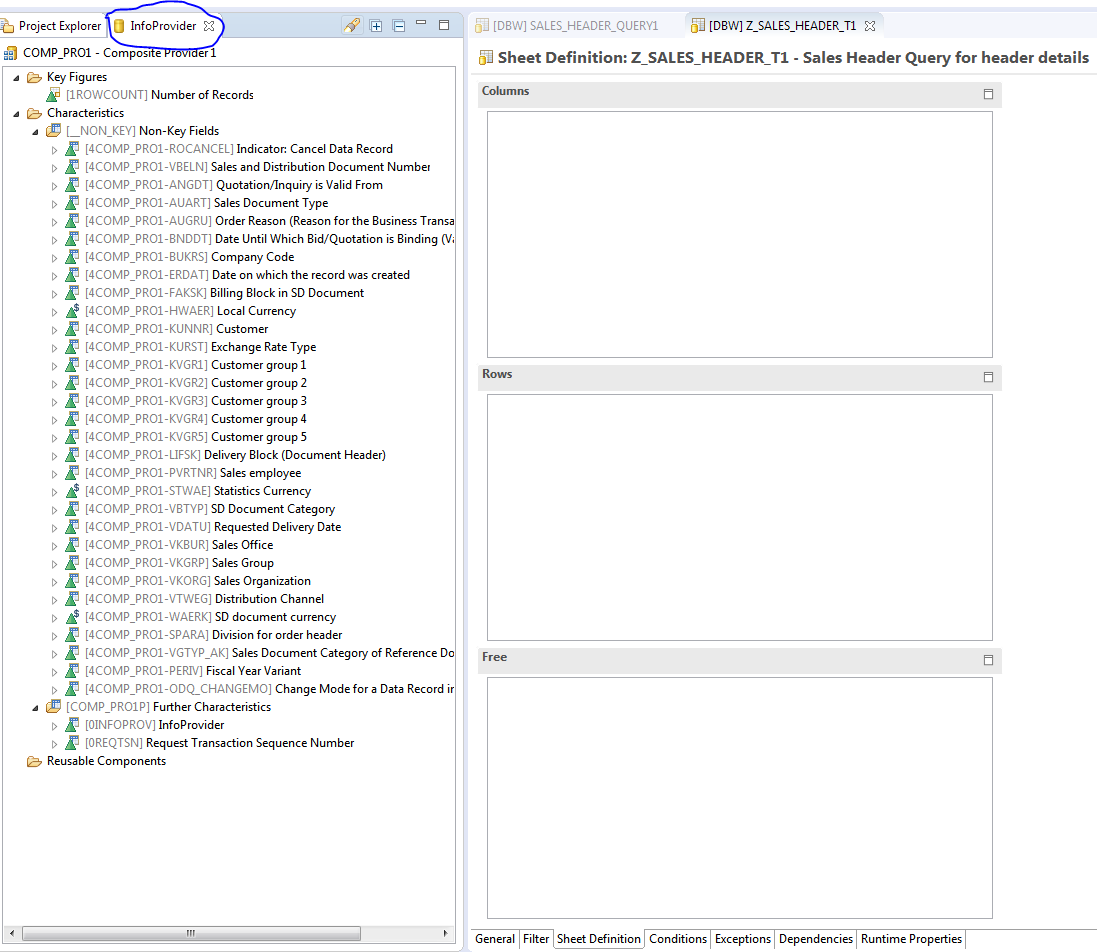
Drag and drop the fields in respective sections.
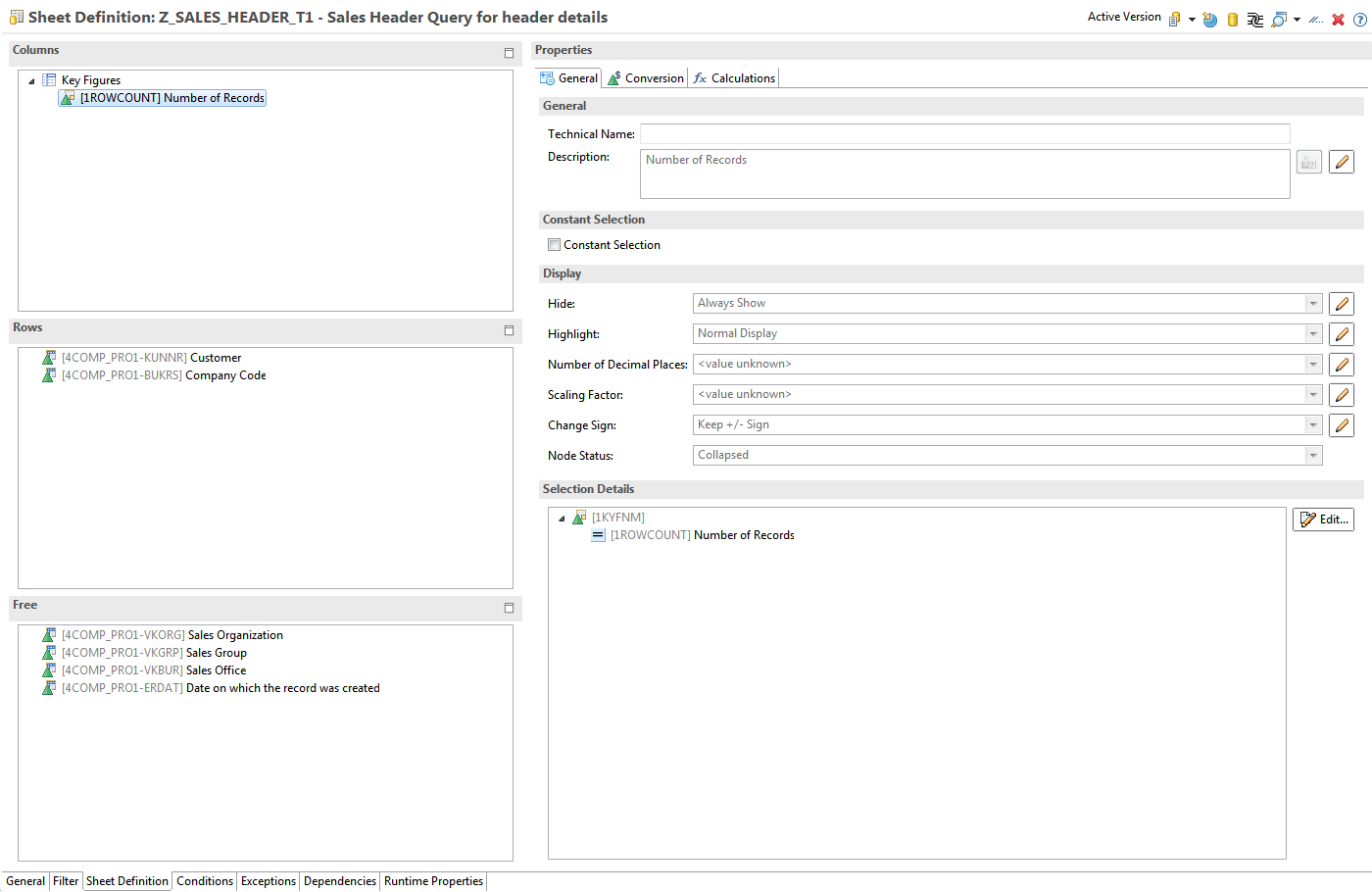
Below you will see the key figure setting and options available. These are like old versions, like the conversions, calculating result as, scaling, renaming the description, add text variable and so on.

The characteristic properties as shown below. Like in the old versions. You can define a hierarchy if available and needed.

You can go to the filter tab to provide any filter restriction if needed. Drag and drop the required field in the top block – Fixed values and right click and restrict.
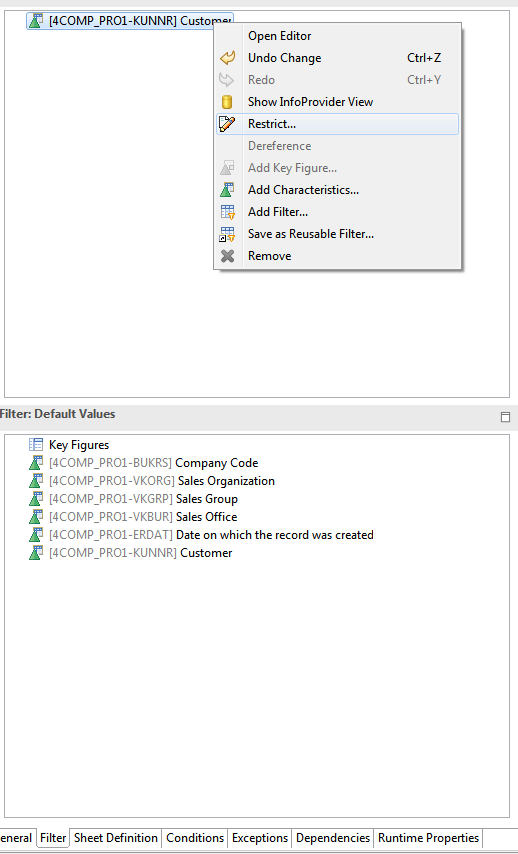
You have the option to restrict on value, variables, hierarchy node variables or nodes itself. Operator selection and ranges can be defined.

You can define conditions like in Bex. Let’s say for example you want to show the top 10 customers.
Goto Conditions tab, right click on condition workspace and New condition

You can change the description, click on Add. You can select the KPI from the member drop down. Select the required operator, in this case, its TopN. Provide the details and OK.
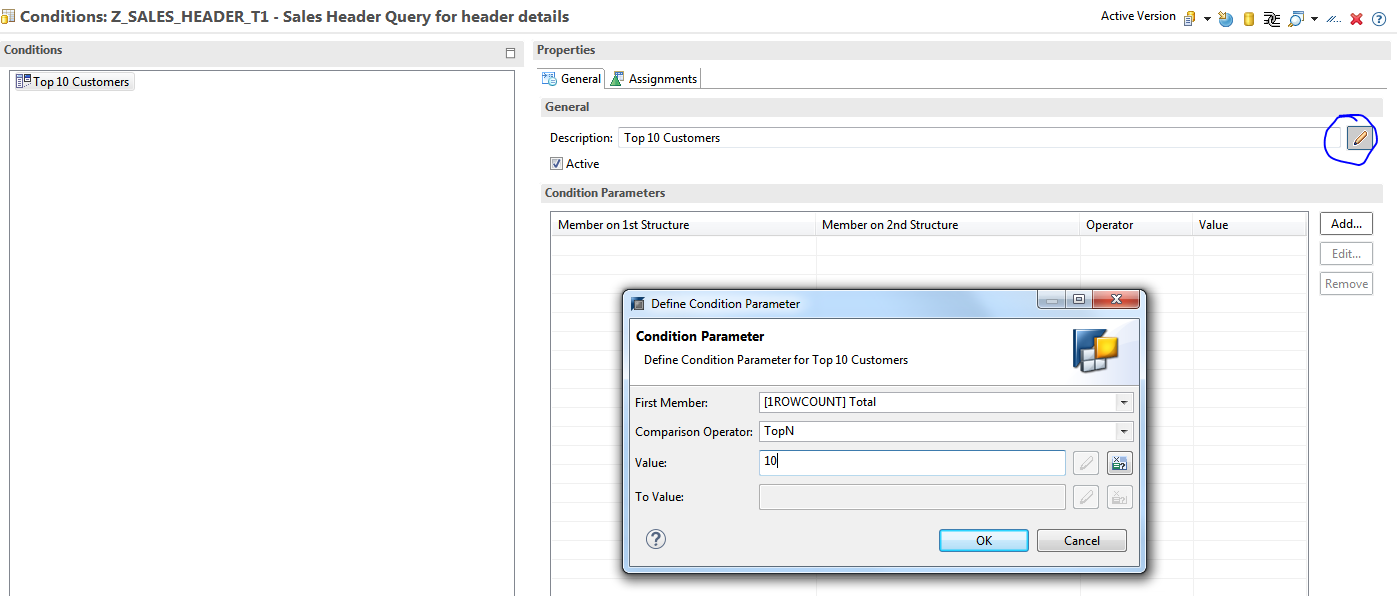
Next is to create an assignment on the field level. Click on Assignments tab and select the field, in this case, it is Customer.

Similarly, you can create Exceptions like in Bex. I will not walk through this. It is very much simple and similar to before.

You can see Dependency Tab. This is handy as well to provide information on any other queries which use the same variable for example as used in your query.
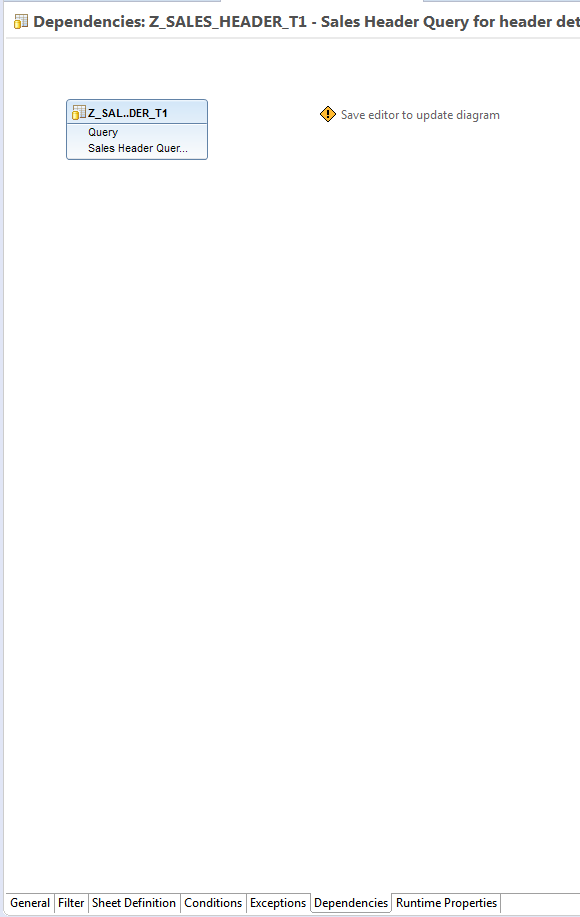
Now coming to the interesting part which is the Runtime properties. This can be defined from the same query space without having to log into separate application or transaction codes.
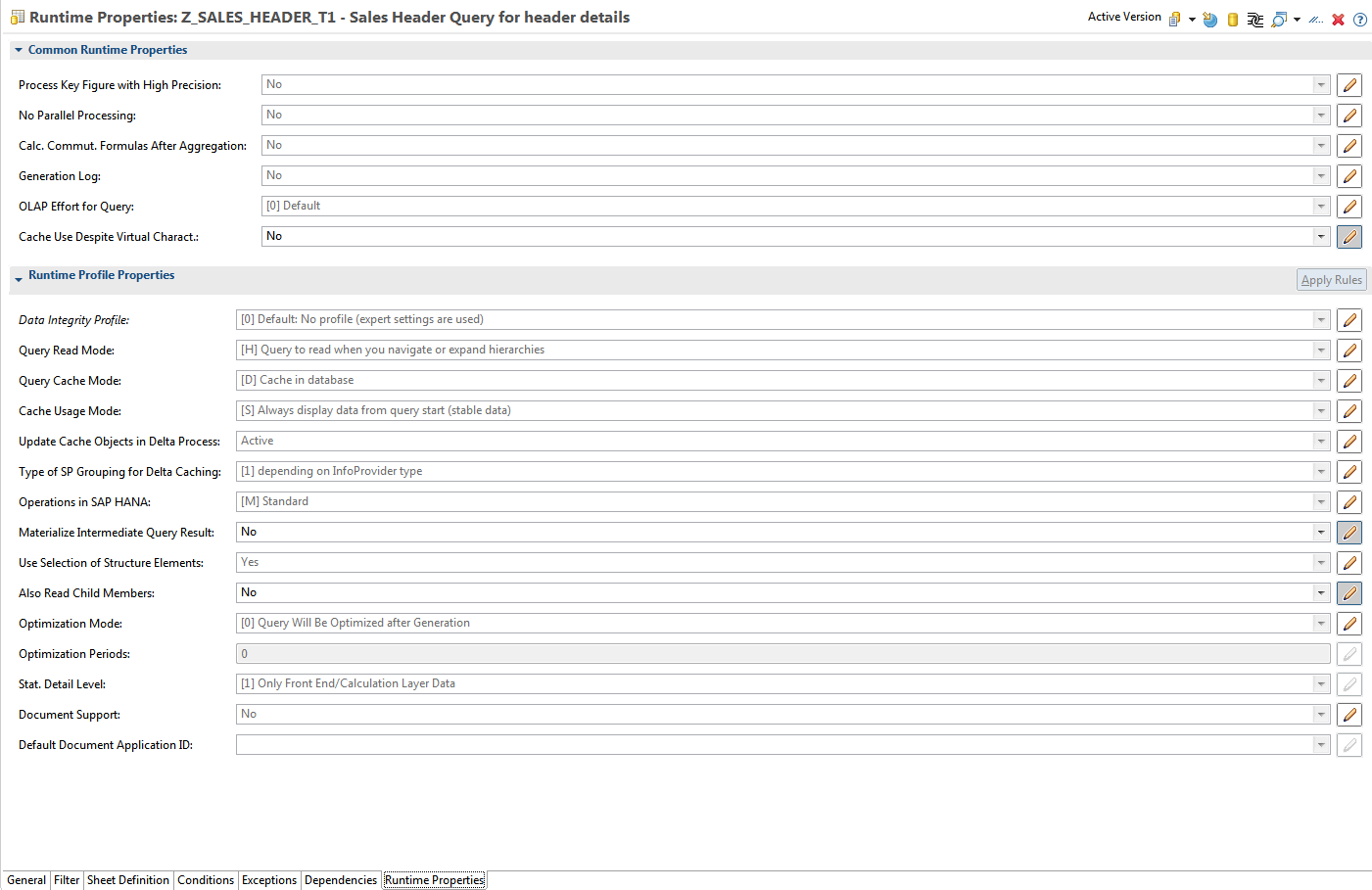
I will try to provide some information on these properties.
Common Runtime properties:
Process Key figure with High Precision – With this, the decimal floating points are stored as 34 decimals and 16 decimals if this setting is not activated.
No Parallel Processing – The query is processed as per info provider by splitting the query into subqueries.
Calculate Commut Formula after Aggregation – Sometimes calculating after aggregation improves performance.
Generation Log – Gives technical details on the query statistics and inconsistencies can be identified.
OLAP Effort for Query – With this, we use the benefits of Analytic Manager to handle queries with large results. There are options to select. If nothing selected then infinite is considered.

Runtime Profile Properties
The initial cache settings are same as old versions. I will talk about some features which would be different or new.
Update Cache objects in delta process – The setting helps to only cache the delta updates and not the entire for the complete rebuilding of cache. In the old version, this was available in RSA1 under info provider level.
Operations in SAP HANA – With this setting, we can optimize the operations in SAP HANA DB if we have HANA as underlying DB.
Materialize Intermediate Query Result – This option enables the reuse of intermediate calculations & subtotals.
Use Selection of Structure Elements - This should be activated to ensure only selections and key figures of the columns are passed to the database.
Read Child Members – With this the filters on the structure element will include all its child nodes/members.
Optimization Mode – This setting is to optimize OLAP processor internal memory size and processing.
Stats Detailed Level – This is to control the detail level for statistical data that can be recorded in the system. In earlier BW versions, this option was only available in the Admin workbench (RSA1).
Once the query design is finalized, go to file and click save.
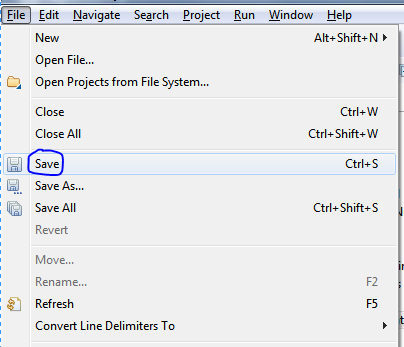
You can find the query under the Composite provider.

I will walk through with creating some other query elements like Variables, restricted/calculated key figures.
Variable
Right click on the query and New Variable

Provide the technical details and selections. The details are similar like in older version.

Type of Variable

Processing by. You can write the exists using the BW GUI in the CMOD like earlier. A new option is create BW variables of processing type SAP HANA Exit

Variable represents

You select the reference characteristic accordingly as applicable and finis

Calculated Key Figure:
You can create CKF on info provider level.
Right click on info provider, in this case, the composite provider

Provide the technical details and finish

In the General Tab, you can define the properties such as Number of decimal places, Scaling, Hide or Display etc. like old versions.

In the Aggregation tab, you can define the exception aggregation condition to be handled and define the reference characteristic.

Any currency conversion definitions can be done in the conversion tab

The calculation definition parameters can be set in Calculations Tab. Like old versions

In the Formula Tab from the bottom of the screen, you can define the formula to be implemented. You have options to use from other objects such as Key figures, RKF, CKF, Variables, and apply different functions available.

Once the CKF has been defined click on save.

You can find the CKF under the Composite provider

Restricted Key Figure:
Right click on the composite provider

Provide Technical details. You have the option to provide the key figure to be used for restriction or you can define this later as well. I will keep this empty for now.

The General Tab is like what is explained in the CKF section. However, you will not see the Aggregation tab here.

In the selection Tab, right click and you can add the objects. You can continue to create nested objects as well and use re-usable components.

You can select the key figure to be used.

Then right click and add a characteristic to apply restriction On.

Once the RKF has been defined click on Save like done for CKF. You can find the RKF under the info provider.

You have the option to include New selection, New formula like in older version. The design interface is very much like earlier versions.

The query can be executed directly and the data can be analyzed in the eclipsed based BW Modelling area.
The query can be accessed in HANA View if the external HAVA View check was selected as mentioned in the steps above.

The Reporting Preview shows the data format with the measures and dimensions defined in the query sheet definition.
The Analysis List UIBB gives more sophisticated data preview.
Hopefully, I shall provide the delta details on how to consume the query in further reporting tools like Analysis for Office/Lumira and in the HANA Views.
Overview
SAP has been constantly evolving with its new innovations in terms of new application upgrades or be it with a completely new application itself as a next-generation solution with better features, integrations, performance and so on.
With BW/4HANA coming in as a next-generation data warehousing solution, SAP has finally put a full stop to very old and good Bex Query designer giving way to a whole modern, user-friendly, eclipse based BW Query modeling. The new terminology in BW/4HANA is called as BW Query.
Until recent SAP BW on HANA versions from BW7.4, BW query existed but was optional. However, from BW 7.5 on HANA SP4, the BW Query eclipse based has become mandatory which means we no longer use the Bex query designer.
BW Query provides a new, improved, well integration of BW data modeling in one single tool. Which means it is one stop place to create BW data models and Queries. For example, in the earlier version, to change query properties, you would have had to log into the back-end system with transaction codes like RSRT. But with new eclipse based query modeling, all this is achieved on a single platform. It is easy to jump from one object to another, view, change whether it Is modeling or query will be done in a single tool.

You can view the query result directly using the drill downs, filters etc., without the need to have a JAVA server for web-based querying or to switch to excel based Bex analyzer tool. What more, these queries can be accessed by other visualizations tools, for example, SAP Lumira to create more sophisticated dashboard representations.
Step by Step to create a BW Query
Let us go through each step on how to create a BW query and to have a look and feel of the eclipse based query modeling layouts and options all in one tool.
Please refer my previous posting on BW/4HANA modeling which I will use here to create a BW query on top of the info provider already existing.
Log into BW/4HANA system and connect to your BW project. Right click on the info provider, here it could be a Master data, advanced DSO, Composite provider, or anything else. Here we use the composite provider.

Provide the technical details and finish. There is an option to copy from existing BW query.

You will go to the General tab section. Here you have familiar options to set, like in Bex query designer. Suppressing results, rows, external access permissions, setting key date parameters and variables settings etc. Another new option is to generate HANA view from BW query itself. Below you can see in Remote access section.

I will jump to Sheet definition as this will initial step to draw the layout of the query. As you see there are three sections which have the same name and mean the same as in old version but with a different layout.

You can find the info provider details on the top left of the screen.

Drag and drop the fields in respective sections.

Below you will see the key figure setting and options available. These are like old versions, like the conversions, calculating result as, scaling, renaming the description, add text variable and so on.

The characteristic properties as shown below. Like in the old versions. You can define a hierarchy if available and needed.

You can go to the filter tab to provide any filter restriction if needed. Drag and drop the required field in the top block – Fixed values and right click and restrict.

You have the option to restrict on value, variables, hierarchy node variables or nodes itself. Operator selection and ranges can be defined.

You can define conditions like in Bex. Let’s say for example you want to show the top 10 customers.
Goto Conditions tab, right click on condition workspace and New condition

You can change the description, click on Add. You can select the KPI from the member drop down. Select the required operator, in this case, its TopN. Provide the details and OK.

Next is to create an assignment on the field level. Click on Assignments tab and select the field, in this case, it is Customer.

Similarly, you can create Exceptions like in Bex. I will not walk through this. It is very much simple and similar to before.

You can see Dependency Tab. This is handy as well to provide information on any other queries which use the same variable for example as used in your query.

Now coming to the interesting part which is the Runtime properties. This can be defined from the same query space without having to log into separate application or transaction codes.

I will try to provide some information on these properties.
Common Runtime properties:
Process Key figure with High Precision – With this, the decimal floating points are stored as 34 decimals and 16 decimals if this setting is not activated.
No Parallel Processing – The query is processed as per info provider by splitting the query into subqueries.
Calculate Commut Formula after Aggregation – Sometimes calculating after aggregation improves performance.
Generation Log – Gives technical details on the query statistics and inconsistencies can be identified.
OLAP Effort for Query – With this, we use the benefits of Analytic Manager to handle queries with large results. There are options to select. If nothing selected then infinite is considered.

Runtime Profile Properties
The initial cache settings are same as old versions. I will talk about some features which would be different or new.
Update Cache objects in delta process – The setting helps to only cache the delta updates and not the entire for the complete rebuilding of cache. In the old version, this was available in RSA1 under info provider level.
Operations in SAP HANA – With this setting, we can optimize the operations in SAP HANA DB if we have HANA as underlying DB.
Materialize Intermediate Query Result – This option enables the reuse of intermediate calculations & subtotals.
Use Selection of Structure Elements - This should be activated to ensure only selections and key figures of the columns are passed to the database.
Read Child Members – With this the filters on the structure element will include all its child nodes/members.
Optimization Mode – This setting is to optimize OLAP processor internal memory size and processing.
Stats Detailed Level – This is to control the detail level for statistical data that can be recorded in the system. In earlier BW versions, this option was only available in the Admin workbench (RSA1).
Once the query design is finalized, go to file and click save.

You can find the query under the Composite provider.

I will walk through with creating some other query elements like Variables, restricted/calculated key figures.
Variable
Right click on the query and New Variable

Provide the technical details and selections. The details are similar like in older version.

Type of Variable

Processing by. You can write the exists using the BW GUI in the CMOD like earlier. A new option is create BW variables of processing type SAP HANA Exit

Variable represents

You select the reference characteristic accordingly as applicable and finis

Calculated Key Figure:
You can create CKF on info provider level.
Right click on info provider, in this case, the composite provider

Provide the technical details and finish

In the General Tab, you can define the properties such as Number of decimal places, Scaling, Hide or Display etc. like old versions.

In the Aggregation tab, you can define the exception aggregation condition to be handled and define the reference characteristic.

Any currency conversion definitions can be done in the conversion tab

The calculation definition parameters can be set in Calculations Tab. Like old versions

In the Formula Tab from the bottom of the screen, you can define the formula to be implemented. You have options to use from other objects such as Key figures, RKF, CKF, Variables, and apply different functions available.

Once the CKF has been defined click on save.

You can find the CKF under the Composite provider

Restricted Key Figure:
Right click on the composite provider

Provide Technical details. You have the option to provide the key figure to be used for restriction or you can define this later as well. I will keep this empty for now.

The General Tab is like what is explained in the CKF section. However, you will not see the Aggregation tab here.

In the selection Tab, right click and you can add the objects. You can continue to create nested objects as well and use re-usable components.

You can select the key figure to be used.

Then right click and add a characteristic to apply restriction On.

Once the RKF has been defined click on Save like done for CKF. You can find the RKF under the info provider.

You have the option to include New selection, New formula like in older version. The design interface is very much like earlier versions.

The query can be executed directly and the data can be analyzed in the eclipsed based BW Modelling area.
The query can be accessed in HANA View if the external HAVA View check was selected as mentioned in the steps above.

The Reporting Preview shows the data format with the measures and dimensions defined in the query sheet definition.
The Analysis List UIBB gives more sophisticated data preview.
Hopefully, I shall provide the delta details on how to consume the query in further reporting tools like Analysis for Office/Lumira and in the HANA Views.
- SAP Managed Tags:
- BW (SAP Business Warehouse),
- SAP BW/4HANA
4 Comments
You must be a registered user to add a comment. If you've already registered, sign in. Otherwise, register and sign in.
Labels in this area
-
"automatische backups"
1 -
"regelmäßige sicherung"
1 -
505 Technology Updates 53
1 -
ABAP
14 -
ABAP API
1 -
ABAP CDS Views
2 -
ABAP CDS Views - BW Extraction
1 -
ABAP CDS Views - CDC (Change Data Capture)
1 -
ABAP class
2 -
ABAP Cloud
2 -
ABAP Development
5 -
ABAP in Eclipse
1 -
ABAP Platform Trial
1 -
ABAP Programming
2 -
abap technical
1 -
access data from SAP Datasphere directly from Snowflake
1 -
Access data from SAP datasphere to Qliksense
1 -
Accrual
1 -
action
1 -
adapter modules
1 -
Addon
1 -
Adobe Document Services
1 -
ADS
1 -
ADS Config
1 -
ADS with ABAP
1 -
ADS with Java
1 -
ADT
2 -
Advance Shipping and Receiving
1 -
Advanced Event Mesh
3 -
AEM
1 -
AI
7 -
AI Launchpad
1 -
AI Projects
1 -
AIML
9 -
Alert in Sap analytical cloud
1 -
Amazon S3
1 -
Analytical Dataset
1 -
Analytical Model
1 -
Analytics
1 -
Analyze Workload Data
1 -
annotations
1 -
API
1 -
API and Integration
3 -
API Call
2 -
Application Architecture
1 -
Application Development
5 -
Application Development for SAP HANA Cloud
3 -
Applications and Business Processes (AP)
1 -
Artificial Intelligence
1 -
Artificial Intelligence (AI)
4 -
Artificial Intelligence (AI) 1 Business Trends 363 Business Trends 8 Digital Transformation with Cloud ERP (DT) 1 Event Information 462 Event Information 15 Expert Insights 114 Expert Insights 76 Life at SAP 418 Life at SAP 1 Product Updates 4
1 -
Artificial Intelligence (AI) blockchain Data & Analytics
1 -
Artificial Intelligence (AI) blockchain Data & Analytics Intelligent Enterprise
1 -
Artificial Intelligence (AI) blockchain Data & Analytics Intelligent Enterprise Oil Gas IoT Exploration Production
1 -
Artificial Intelligence (AI) blockchain Data & Analytics Intelligent Enterprise sustainability responsibility esg social compliance cybersecurity risk
1 -
ASE
1 -
ASR
2 -
ASUG
1 -
Attachments
1 -
Authorisations
1 -
Automating Processes
1 -
Automation
1 -
aws
2 -
Azure
1 -
Azure AI Studio
1 -
B2B Integration
1 -
Backorder Processing
1 -
Backup
1 -
Backup and Recovery
1 -
Backup schedule
1 -
BADI_MATERIAL_CHECK error message
1 -
Bank
1 -
BAS
1 -
basis
2 -
Basis Monitoring & Tcodes with Key notes
2 -
Batch Management
1 -
BDC
1 -
Best Practice
1 -
bitcoin
1 -
Blockchain
3 -
BOP in aATP
1 -
BOP Segments
1 -
BOP Strategies
1 -
BOP Variant
1 -
BPC
1 -
BPC LIVE
1 -
BTP
11 -
BTP Destination
2 -
Business AI
1 -
Business and IT Integration
1 -
Business application stu
1 -
Business Architecture
1 -
Business Communication Services
1 -
Business Continuity
1 -
Business Data Fabric
3 -
Business Partner
12 -
Business Partner Master Data
10 -
Business Technology Platform
2 -
Business Trends
1 -
CA
1 -
calculation view
1 -
CAP
2 -
Capgemini
1 -
Catalyst for Efficiency: Revolutionizing SAP Integration Suite with Artificial Intelligence (AI) and
1 -
CCMS
2 -
CDQ
12 -
CDS
2 -
Cental Finance
1 -
Certificates
1 -
CFL
1 -
Change Management
1 -
chatbot
1 -
chatgpt
3 -
CL_SALV_TABLE
2 -
Class Runner
1 -
Classrunner
1 -
Cloud ALM Monitoring
1 -
Cloud ALM Operations
1 -
cloud connector
1 -
Cloud Extensibility
1 -
Cloud Foundry
3 -
Cloud Integration
6 -
Cloud Platform Integration
2 -
cloudalm
1 -
communication
1 -
Compensation Information Management
1 -
Compensation Management
1 -
Compliance
1 -
Compound Employee API
1 -
Configuration
1 -
Connectors
1 -
Conversion
1 -
Cosine similarity
1 -
cryptocurrency
1 -
CSI
1 -
ctms
1 -
Custom chatbot
3 -
Custom Destination Service
1 -
custom fields
1 -
Customer Experience
1 -
Customer Journey
1 -
Customizing
1 -
Cyber Security
2 -
Data
1 -
Data & Analytics
1 -
Data Aging
1 -
Data Analytics
2 -
Data and Analytics (DA)
1 -
Data Archiving
1 -
Data Back-up
1 -
Data Governance
5 -
Data Integration
2 -
Data Quality
12 -
Data Quality Management
12 -
Data Synchronization
1 -
data transfer
1 -
Data Unleashed
1 -
Data Value
8 -
database tables
1 -
Datasphere
2 -
datenbanksicherung
1 -
dba cockpit
1 -
dbacockpit
1 -
Debugging
2 -
Delimiting Pay Components
1 -
Delta Integrations
1 -
Destination
3 -
Destination Service
1 -
Developer extensibility
1 -
Developing with SAP Integration Suite
1 -
Devops
1 -
Digital Transformation
1 -
Documentation
1 -
Dot Product
1 -
DQM
1 -
dump database
1 -
dump transaction
1 -
e-Invoice
1 -
E4H Conversion
1 -
Eclipse ADT ABAP Development Tools
2 -
edoc
1 -
edocument
1 -
ELA
1 -
Embedded Consolidation
1 -
Embedding
1 -
Embeddings
1 -
Employee Central
1 -
Employee Central Payroll
1 -
Employee Central Time Off
1 -
Employee Information
1 -
Employee Rehires
1 -
Enable Now
1 -
Enable now manager
1 -
endpoint
1 -
Enhancement Request
1 -
Enterprise Architecture
1 -
ETL Business Analytics with SAP Signavio
1 -
Euclidean distance
1 -
Event Dates
1 -
Event Driven Architecture
1 -
Event Mesh
2 -
Event Reason
1 -
EventBasedIntegration
1 -
EWM
1 -
EWM Outbound configuration
1 -
EWM-TM-Integration
1 -
Existing Event Changes
1 -
Expand
1 -
Expert
2 -
Expert Insights
1 -
Fiori
14 -
Fiori Elements
2 -
Fiori SAPUI5
12 -
Flask
1 -
Full Stack
8 -
Funds Management
1 -
General
1 -
Generative AI
1 -
Getting Started
1 -
GitHub
8 -
Grants Management
1 -
groovy
1 -
GTP
1 -
HANA
5 -
HANA Cloud
2 -
Hana Cloud Database Integration
2 -
HANA DB
1 -
HANA XS Advanced
1 -
Historical Events
1 -
home labs
1 -
HowTo
1 -
HR Data Management
1 -
html5
8 -
idm
1 -
Implementation
1 -
input parameter
1 -
instant payments
1 -
integration
3 -
Integration Advisor
1 -
Integration Architecture
1 -
Integration Center
1 -
Integration Suite
1 -
intelligent enterprise
1 -
Java
1 -
job
1 -
Job Information Changes
1 -
Job-Related Events
1 -
Job_Event_Information
1 -
joule
4 -
Journal Entries
1 -
Just Ask
1 -
Kerberos for ABAP
8 -
Kerberos for JAVA
8 -
Launch Wizard
1 -
Learning Content
2 -
Life at SAP
1 -
lightning
1 -
Linear Regression SAP HANA Cloud
1 -
local tax regulations
1 -
LP
1 -
Machine Learning
2 -
Marketing
1 -
Master Data
3 -
Master Data Management
14 -
Maxdb
2 -
MDG
1 -
MDGM
1 -
MDM
1 -
Message box.
1 -
Messages on RF Device
1 -
Microservices Architecture
1 -
Microsoft Universal Print
1 -
Middleware Solutions
1 -
Migration
5 -
ML Model Development
1 -
Modeling in SAP HANA Cloud
8 -
Monitoring
3 -
MTA
1 -
Multi-Record Scenarios
1 -
Multiple Event Triggers
1 -
Neo
1 -
New Event Creation
1 -
New Feature
1 -
Newcomer
1 -
NodeJS
1 -
ODATA
2 -
OData APIs
1 -
odatav2
1 -
ODATAV4
1 -
ODBC
1 -
ODBC Connection
1 -
Onpremise
1 -
open source
2 -
OpenAI API
1 -
Oracle
1 -
PaPM
1 -
PaPM Dynamic Data Copy through Writer function
1 -
PaPM Remote Call
1 -
PAS-C01
1 -
Pay Component Management
1 -
PGP
1 -
Pickle
1 -
PLANNING ARCHITECTURE
1 -
Popup in Sap analytical cloud
1 -
PostgrSQL
1 -
POSTMAN
1 -
Process Automation
2 -
Product Updates
4 -
PSM
1 -
Public Cloud
1 -
Python
4 -
Qlik
1 -
Qualtrics
1 -
RAP
3 -
RAP BO
2 -
Record Deletion
1 -
Recovery
1 -
recurring payments
1 -
redeply
1 -
Release
1 -
Remote Consumption Model
1 -
Replication Flows
1 -
Research
1 -
Resilience
1 -
REST
1 -
REST API
1 -
Retagging Required
1 -
Risk
1 -
Rolling Kernel Switch
1 -
route
1 -
rules
1 -
S4 HANA
1 -
S4 HANA Cloud
1 -
S4 HANA On-Premise
1 -
S4HANA
3 -
S4HANA_OP_2023
2 -
SAC
10 -
SAC PLANNING
9 -
SAP
4 -
SAP ABAP
1 -
SAP Advanced Event Mesh
1 -
SAP AI Core
8 -
SAP AI Launchpad
8 -
SAP Analytic Cloud Compass
1 -
Sap Analytical Cloud
1 -
SAP Analytics Cloud
4 -
SAP Analytics Cloud for Consolidation
1 -
SAP Analytics Cloud Story
1 -
SAP analytics clouds
1 -
SAP BAS
1 -
SAP Basis
6 -
SAP BODS
1 -
SAP BODS certification.
1 -
SAP BTP
20 -
SAP BTP Build Work Zone
2 -
SAP BTP Cloud Foundry
5 -
SAP BTP Costing
1 -
SAP BTP CTMS
1 -
SAP BTP Innovation
1 -
SAP BTP Migration Tool
1 -
SAP BTP SDK IOS
1 -
SAP Build
11 -
SAP Build App
1 -
SAP Build apps
1 -
SAP Build CodeJam
1 -
SAP Build Process Automation
3 -
SAP Build work zone
10 -
SAP Business Objects Platform
1 -
SAP Business Technology
2 -
SAP Business Technology Platform (XP)
1 -
sap bw
1 -
SAP CAP
1 -
SAP CDC
1 -
SAP CDP
1 -
SAP Certification
1 -
SAP Cloud ALM
4 -
SAP Cloud Application Programming Model
1 -
SAP Cloud Integration for Data Services
1 -
SAP cloud platform
8 -
SAP Companion
1 -
SAP CPI
3 -
SAP CPI (Cloud Platform Integration)
2 -
SAP CPI Discover tab
1 -
sap credential store
1 -
SAP Customer Data Cloud
1 -
SAP Customer Data Platform
1 -
SAP Data Intelligence
1 -
SAP Data Services
1 -
SAP DATABASE
1 -
SAP Dataspher to Non SAP BI tools
1 -
SAP Datasphere
9 -
SAP DRC
1 -
SAP EWM
1 -
SAP Fiori
2 -
SAP Fiori App Embedding
1 -
Sap Fiori Extension Project Using BAS
1 -
SAP GRC
1 -
SAP HANA
1 -
SAP HCM (Human Capital Management)
1 -
SAP HR Solutions
1 -
SAP IDM
1 -
SAP Integration Suite
9 -
SAP Integrations
4 -
SAP iRPA
2 -
SAP Learning Class
1 -
SAP Learning Hub
1 -
SAP Odata
2 -
SAP on Azure
1 -
SAP PartnerEdge
1 -
sap partners
1 -
SAP Password Reset
1 -
SAP PO Migration
1 -
SAP Prepackaged Content
1 -
SAP Process Automation
2 -
SAP Process Integration
2 -
SAP Process Orchestration
1 -
SAP S4HANA
2 -
SAP S4HANA Cloud
1 -
SAP S4HANA Cloud for Finance
1 -
SAP S4HANA Cloud private edition
1 -
SAP Sandbox
1 -
SAP STMS
1 -
SAP SuccessFactors
2 -
SAP SuccessFactors HXM Core
1 -
SAP Time
1 -
SAP TM
2 -
SAP Trading Partner Management
1 -
SAP UI5
1 -
SAP Upgrade
1 -
SAP-GUI
8 -
SAP_COM_0276
1 -
SAPBTP
1 -
SAPCPI
1 -
SAPEWM
1 -
sapmentors
1 -
saponaws
2 -
SAPUI5
4 -
schedule
1 -
Secure Login Client Setup
8 -
security
9 -
Selenium Testing
1 -
SEN
1 -
SEN Manager
1 -
service
1 -
SET_CELL_TYPE
1 -
SET_CELL_TYPE_COLUMN
1 -
SFTP scenario
2 -
Simplex
1 -
Single Sign On
8 -
Singlesource
1 -
SKLearn
1 -
soap
1 -
Software Development
1 -
SOLMAN
1 -
solman 7.2
2 -
Solution Manager
3 -
sp_dumpdb
1 -
sp_dumptrans
1 -
SQL
1 -
sql script
1 -
SSL
8 -
SSO
8 -
SuccessFactors
1 -
SuccessFactors Time Tracking
1 -
Sybase
1 -
system copy method
1 -
System owner
1 -
Table splitting
1 -
Tax Integration
1 -
Technical article
1 -
Technical articles
1 -
Technology Updates
1 -
Technology Updates
1 -
Technology_Updates
1 -
Threats
1 -
Time Collectors
1 -
Time Off
2 -
Tips and tricks
2 -
Tools
1 -
Trainings & Certifications
1 -
Transport in SAP BODS
1 -
Transport Management
1 -
TypeScript
1 -
unbind
1 -
Unified Customer Profile
1 -
UPB
1 -
Use of Parameters for Data Copy in PaPM
1 -
User Unlock
1 -
VA02
1 -
Vector Database
1 -
Vector Engine
1 -
Visual Studio Code
1 -
VSCode
1 -
Web SDK
1 -
work zone
1 -
workload
1 -
xsa
1 -
XSA Refresh
1
- « Previous
- Next »
Related Content
- Exploring Integration Options in SAP Datasphere with the focus on using SAP extractors in Technology Blogs by SAP
- Restrict web based data maintenance tool for characteristic based on one compound object in Technology Q&A
- Unraveling the SAP DataSphere: Insights in bite-sized pieces in Technology Blogs by Members
- Fiori List Report Application using CDS Views and CDS Annotations with Eclipse and Visual Studio Code in Technology Blogs by Members
- ASUG TECH CONNECT in New Orleans 2023 in Technology Blogs by Members
Top kudoed authors
| User | Count |
|---|---|
| 8 | |
| 8 | |
| 7 | |
| 6 | |
| 4 | |
| 4 | |
| 4 | |
| 4 | |
| 3 | |
| 3 |